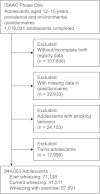Low birth weight and environmental tobacco smoke increases the risk of wheezing in adolescents: a retrospective cohort study
- PMID: 24996444
- PMCID: PMC4099085
- DOI: 10.1186/1471-2458-14-688
Low birth weight and environmental tobacco smoke increases the risk of wheezing in adolescents: a retrospective cohort study
Abstract
Background: Low birth weight (LBW) and environmental tobacco smoke (ETS) exposure are each associated with wheezing in children. This study was designed to examine the combined association of LBW and ETS with wheezing.
Methods: A retrospective birth cohort analysis linked with a national survey of allergic disorders among 1,018,031 junior high school students in Taiwan (1995-1996) was analyzed. The reported incidence of wheezing (yes or no) and ETS exposure (4 categories: 0, 1-20, 21-40 and greater than or equal to 41 household cigarettes per day) were obtained from validated questionnaires. Multiple logistic regression models were used to assess the associations of interest.
Results: There were 844,003 (83%) subjects analyzed after the exclusion criteria. LBW was associated with an increased risk of reporting ever wheezing (odds ratio [OR] = 1.08, 95% confidence interval [CI] = 1.01-1.16), current wheezing (OR = 1.09, 95% CI = 1.00-1.20) and wheezing with exercise (OR = 1.11, 95% CI = 1.02-1.21) within the smoke-free cohort. Higher ETS exposure correlated to a higher risk of wheezing (ever, current and with exercise). With ETS exposure, adolescents from the lowest birth weight cohorts were more likely to report wheezing (ever, current and with exercise).
Conclusions: ETS and LBW each has been related to increasing public health risk for respiratory symptoms among adolescents. Furthermore, LBW may aggravate the risk among those exposed to ETS. LBW, ETS and associated respiratory impairments may deserve special attention as part of a comprehensive environmental health risk assessment directed toward prevention and intervention.
Figures
References
-
- Chilmonczyk BA, Salmun LM, Megathlin KN, Neveux LM, Palomaki GE, Knight GJ, Pulkkinen AJ, Haddow JE. Association between exposure to environmental tobacco smoke and exacerbations of asthma in children. N Engl J Med. 1993;328:1665–1669. - PubMed
-
- Mackay D, Haw S, Ayres JG, Fischbacher C, Pell JP. Smoke-free legislation and hospitalizations for childhood asthma. N Engl J Med. 2010;363:1139–1145. - PubMed
-
- Kabir Z, Manning PJ, Holohan J, Keogan S, Goodman PG, Clancy L. Second-hand smoke exposure in cars and respiratory health effects in children. Eur Respir J. 2009;34:629–633. - PubMed
Publication types
MeSH terms
Substances
Grants and funding
LinkOut - more resources
Full Text Sources
Other Literature Sources
Medical


